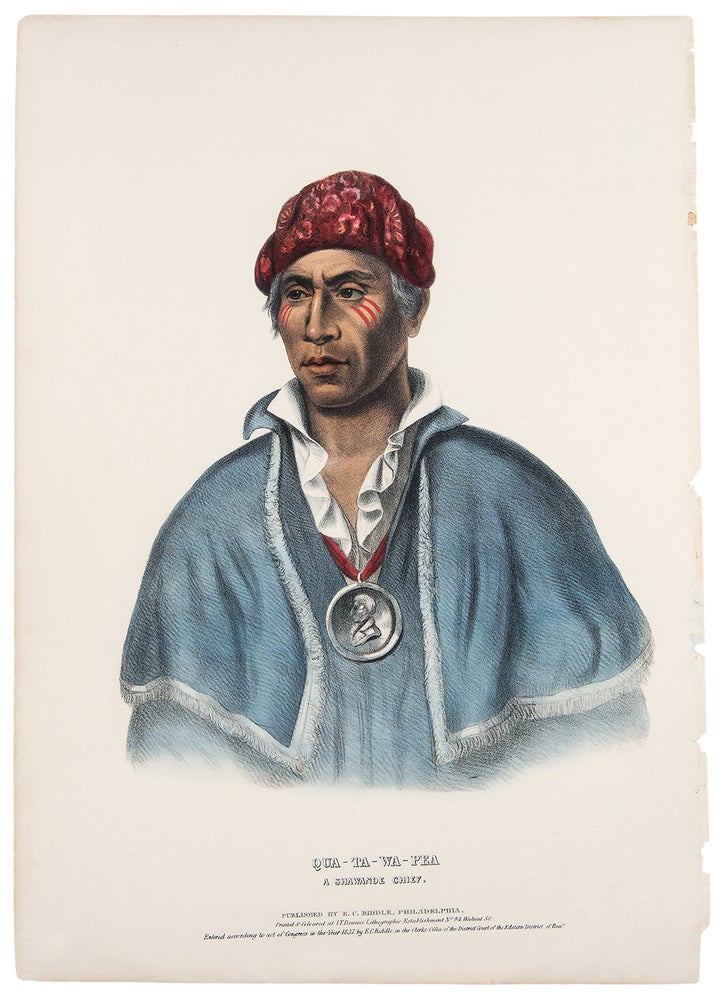MCKENNEY, Thomas L. (1785-1859) and James HALL (1793-1868)
Qua-Ta-Wa-Pea or Col. Lewis. A Shawnee Chief
Philadelphia: E. C. Biddle, 1837. Hand-coloured lithograph by J. T. Bowen. In excellent condition. Sheet size: 17 15/16 x 12 11/16 inches.
A fine image from McKenney and Hall's 'Indian Tribes of North America': `One of the most important [works] ever published on the American Indians' (Field),` a landmark in American culture' (Horan) and an invaluable contemporary record of a vanished way of life.
A courageous Shawnee chief, Quatawapea, also known as Colonel John Lewis, was rumored to have been elected leader because the Shawnee interpreted President Jefferson's act of honoring him with a medal during a visit to Washington as a sign that that was the will of the United States. That at least is the legend reported by McKenney. More recent research suggests that he was a commissioned officer during the War of 1812 and subsequently under the protection of the U.S. government. He and his people were settled in Ohio until 1819, then moved to the White River region of Arkansas. In 1829, they were moved again to the reservation at Leavenworth, Kansas, though Quatawapea died in 1826. McKenney and Hall's 'Indian Tribes of North America' has long been renowned for its faithful portraits of Native Americans. The portraits are largely based on paintings by the artist Charles Bird King, who was employed by the War Department to paint the Indian delegates visiting Washington D.C., forming the basis of the War Department's Indian Gallery. Most of King's original paintings were subsequently destroyed in a fire at the Smithsonian, and their appearance in McKenney and Hall's magnificent work is thus our only record of the likenesses of many of the most prominent Indian leaders of the nineteenth century. Numbered among King's sitters were Sequoyah, Red Jacket, Major Ridge, Keokuk, and Black Hawk. After six years as Superintendent of Indian Trade, Thomas McKenney had become concerned for the survival of the Western tribes. He had observed unscrupulous individuals taking advantage of the Native Americans for profit, and his vocal warnings about their future prompted his appointment by President Monroe to the Office of Indian Affairs. As first director, McKenney was to improve the administration of Indian programs in various government offices. His first trip was during the summer of 1826 to the Lake Superior area for a treaty with the Chippewa, opening mineral rights on their land. In 1827, he journeyed west again for a treaty with the Chippewa, Menominee, and Winnebago in the present state of Michigan. His journeys provided an unparalleled opportunity to become acquainted with Native American tribes. When President Jackson dismissed him from his government post in 1830, McKenney was able to turn more of his attention to his publishing project. Within a few years, he was joined by James Hall, a lawyer who had written extensively about the west. McKenney and Hall saw their work as a way of preserving an accurate visual record of a rapidly disappearing culture (Gilreath).
Cf. Howes M129; cf. Bennett 79; cf. Field 992; cf. Lipperheide Mc 4; cf. Reese American Color Plate Books 24; cf. Sabin 43410a.
Item #26105
Price: $400.00


